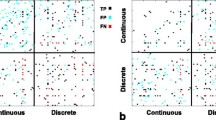Abstract
Given a random sample drawn from a Multivariate Bernoulli Variable (MBV), we consider the problem of estimating the structure of the undirected graph for which the distribution is pairwise Markov and the parameters’ vector of its exponential form. We propose a simple method that provides a closed form estimator of the parameters’ vector and through its support also provides an estimate of the undirected graph associated with the MBV distribution. The estimator is proved to be asymptotically consistent but it is feasible only in low-dimensional regimes. Synthetic examples illustrate its performance compared with another method that represents state of the art in literature. Finally, the proposed procedure is used to analyze a data set in the pediatric allergology area showing its practical efficiency.

Similar content being viewed by others
References
Besag, J.: Spatial interaction and the statistical analysis of lattice systems. J. R. Stat. Soc. Ser. B 36(2), 192–225 (1974)
Blake, A., Kohli, P., Rother, C.: Markov Random Fields for Vision and Image Processing. MIT Press, Cambridge, MA (2011)
Blyth, C.B.: On Simpson’s paradox and the sure-thing principle. J. Am. Stat. Assoc. 67(338), 364–366 (1972)
Canonne L.C., Diakonikolas I., Kane D.M., Stewart A.: Testing conditional independence of discrete distributions. arXiv:1711.11560 [cs.DS] (2018)
Dai, B., Ding, S., Wahba, G.: Multivariate Bernoulli Distribution Bernoulli 19(4), 1465–1483 (2013)
De Canditiis, D.: A global approach for learning sparse Ising models. Math. Comput. Simul. 176, 160–170 (2020)
Giraud, C.: Introduction to High-dimensional Statistics. Chapman and Hall book, London (2015)
Lauritzen, S.L.: Graphical Models. Oxford Science Publications, Oxford (1996)
Hofling, H., Tibshirani, R.: Estimation of sparse binary pairwise Markov networks using Pseudo-likelihoods. J. Mach. Learn. Res. 10, 883–906 (2009)
Loh, P.B., Wainwright, M.J.: Structure estimation for discrete graphical models: generalized covariance matrices and their inverse. Ann. Stat. 41(6), 3022–3049 (2013)
Marx, A., Vreeken, J.: Testing conditional independence on discrete data using stochastic complexity. In: Proceedings of the 22nd International Conference on Artiphicial Intelligence and Statistics (AISTATS) 2019, Naha, Okinawa, Japan, vol. 89. PMLR (2019)
Penrose, M.: Random Geometric Graph. Oxford University Press, Oxford (2004)
Popescu, F.D.: Cross-reactivity between aeroallergens and food allergens. World J. Methodol. 5(2), 31–50 (2015)
Schaeben, H.: Testing joint conditional independence of categorical random variables with a standard log-likelihood ratio test. In: Daya, Sagar B., Cheng, Q., Agterberg, F. (eds.) Handbook of Mathematical Geosciences. Springer, Cham (2018)
Ravikumar, P., Wainwright, M.J., Lafferty, J.D.: High-dimensional Ising model selection using \(l1\)-regularized logistic regression. Ann. Stat. 38(3), 1287–1319 (2010)
Roverato, A.: Graphical Models for Categorical Data. Cambridge University Press, Cambridge (2017)
Zhang, k., Peters, J., Janzing, D., Schoelkopf, B.: Kernel-based conditional independence test and application in causal discovery UAI’11. In: Proceedings of the Twenty-Seventh Conference on Uncertainty in Artificial Intelligence, pp. 804–813 (2011)
Acknowledgements
The author thanks Proff. Caterina Anania and Vincenza Di Marino of the Pediatric Allergology Department of Policlinico Umberto I in Rome for having provided the data and their valuable explanations. This work was supported by the GNCS2022 project “Metodi computazionali per la costruzione e l’analisi di modelli matematici in biomedicina”
Author information
Authors and Affiliations
Contributions
The author wrote all Sections.
Corresponding author
Ethics declarations
conflict of interest
The authors declare no competing interests.
Additional information
Publisher's Note
Springer Nature remains neutral with regard to jurisdictional claims in published maps and institutional affiliations.
Rights and permissions
Springer Nature or its licensor (e.g. a society or other partner) holds exclusive rights to this article under a publishing agreement with the author(s) or other rightsholder(s); author self-archiving of the accepted manuscript version of this article is solely governed by the terms of such publishing agreement and applicable law.
About this article
Cite this article
De Canditiis, D. Learning binary undirected graph in low dimensional regime. Stat Comput 33, 133 (2023). https://doi.org/10.1007/s11222-023-10321-4
Received:
Accepted:
Published:
DOI: https://doi.org/10.1007/s11222-023-10321-4




